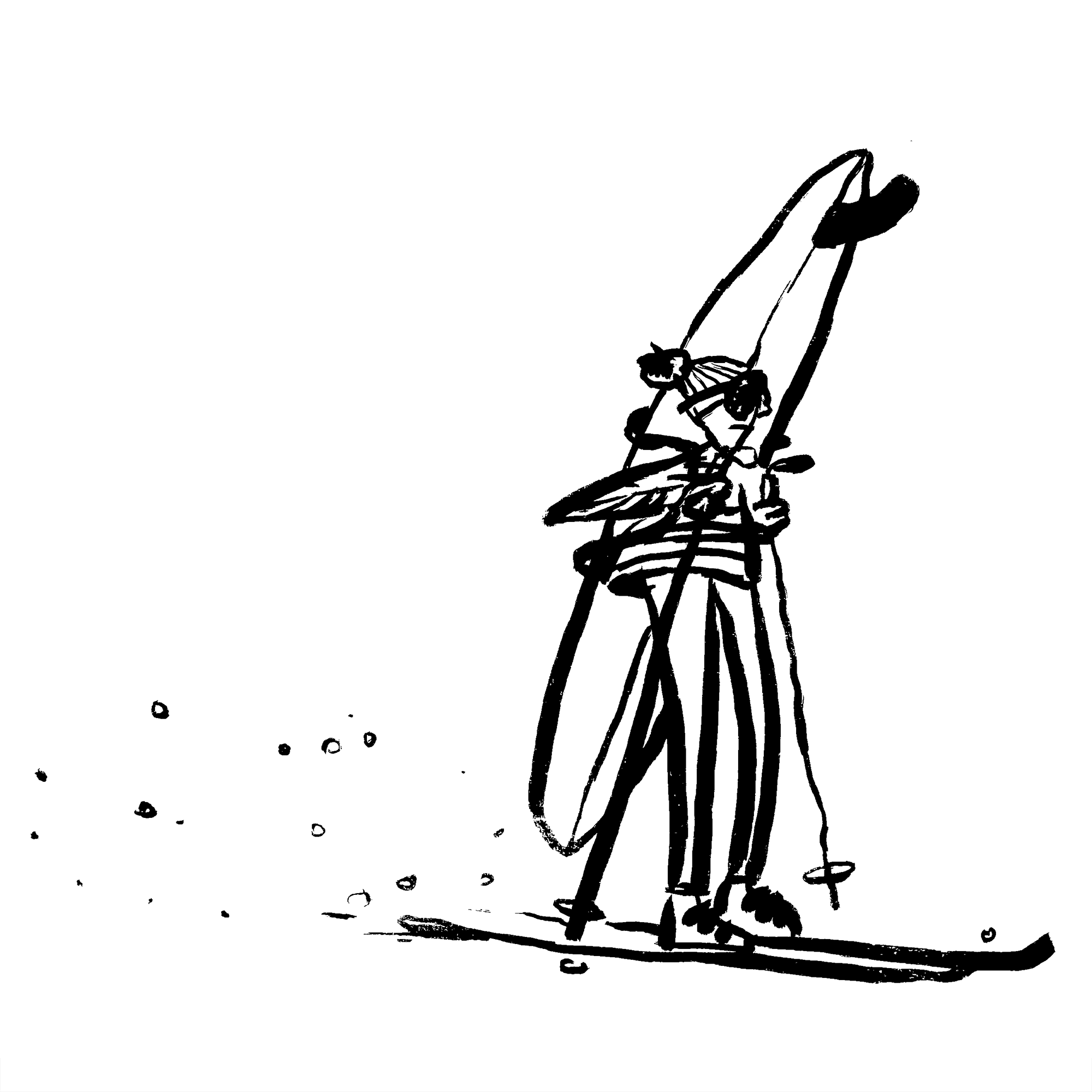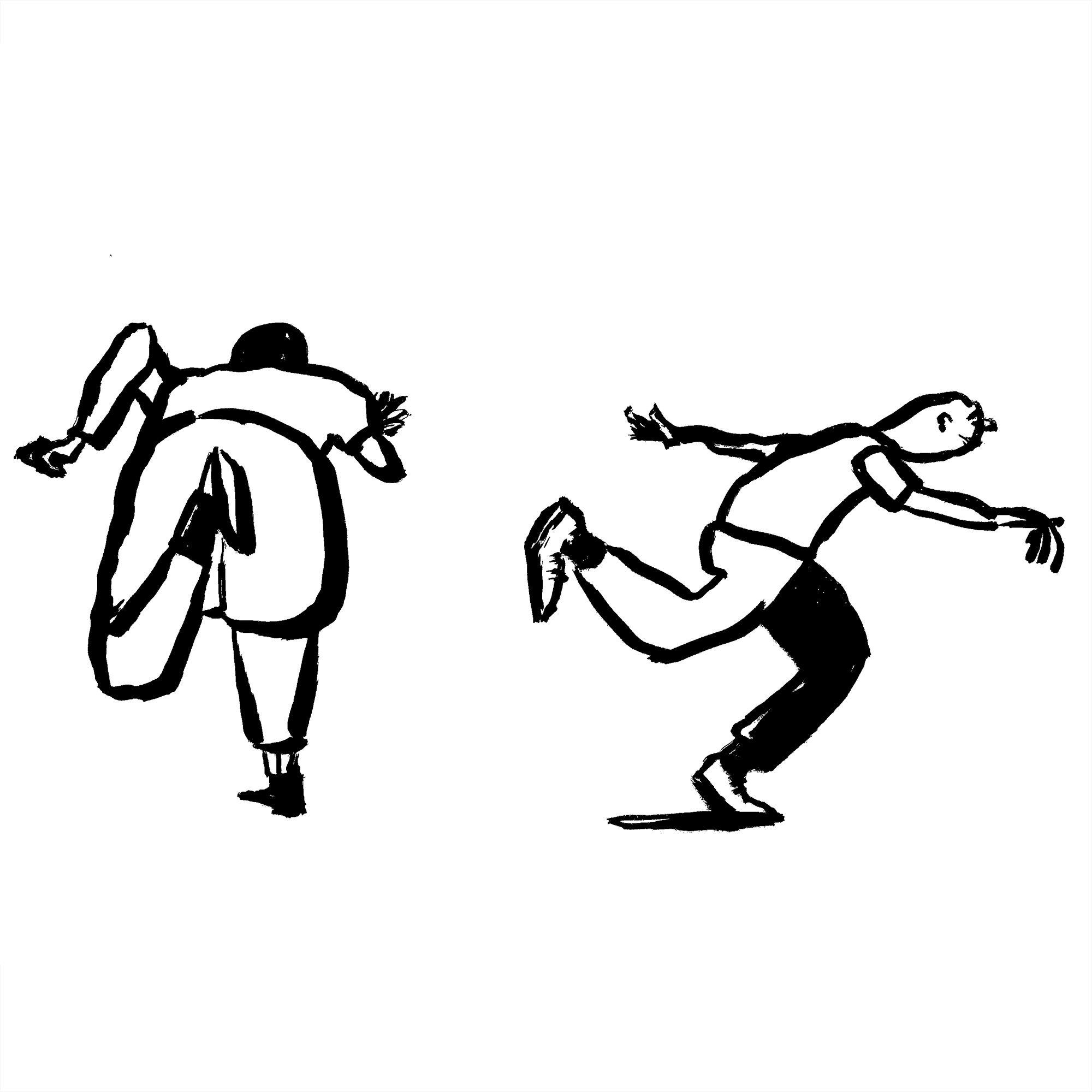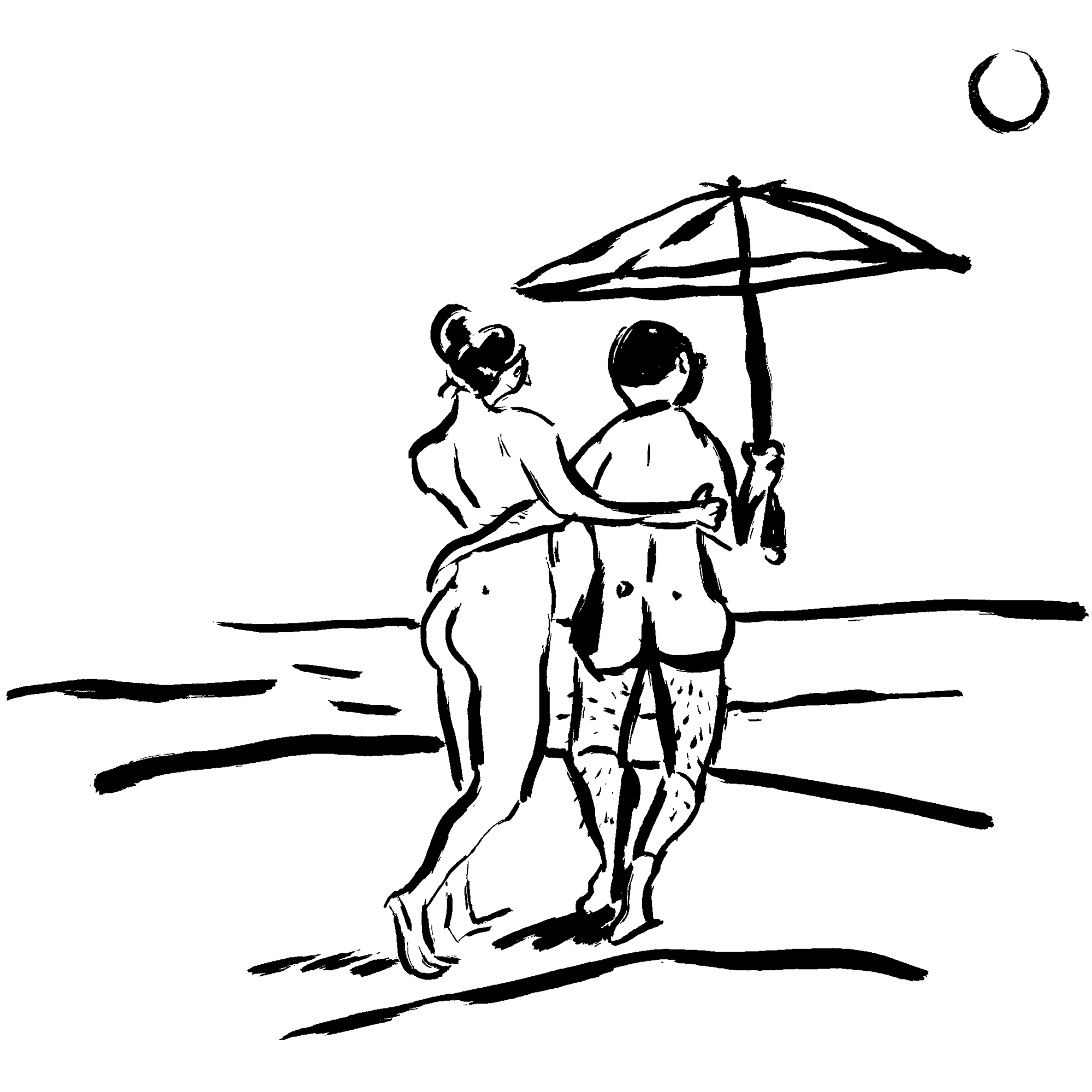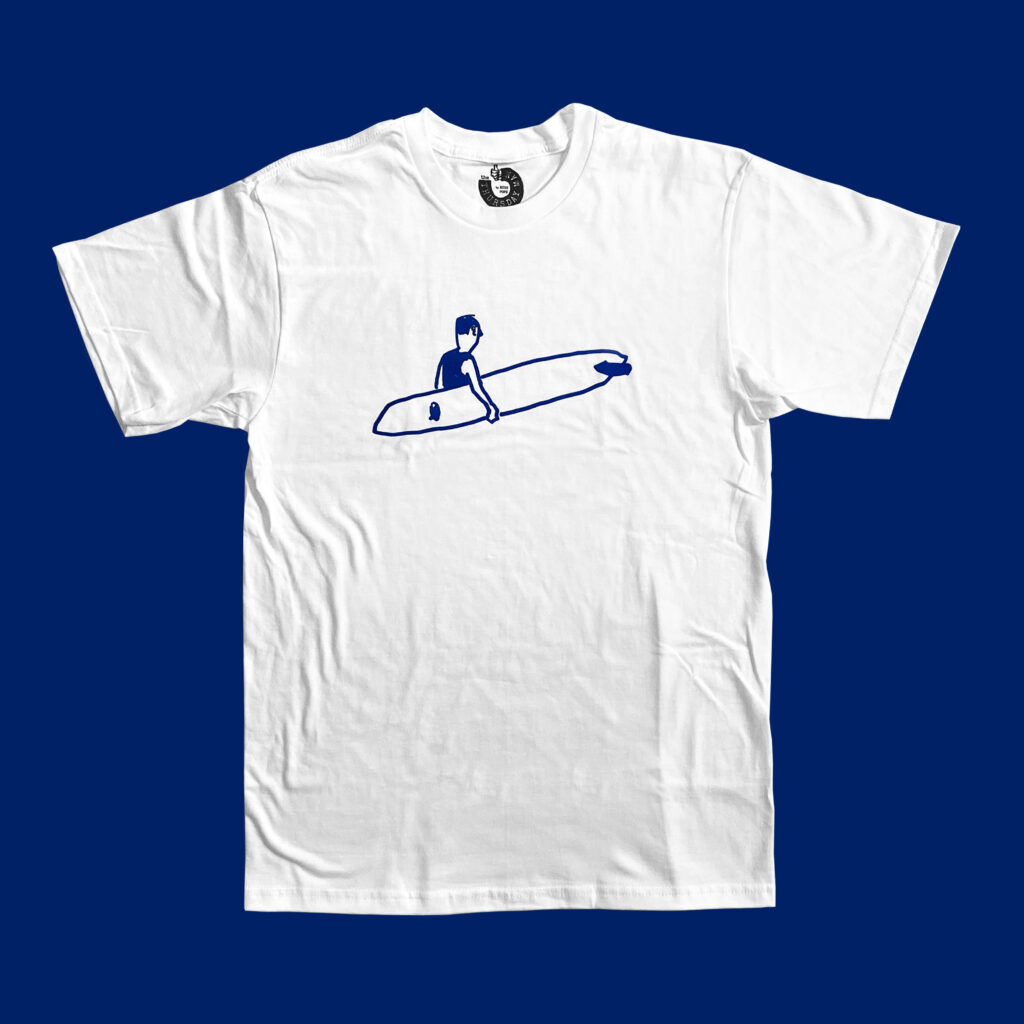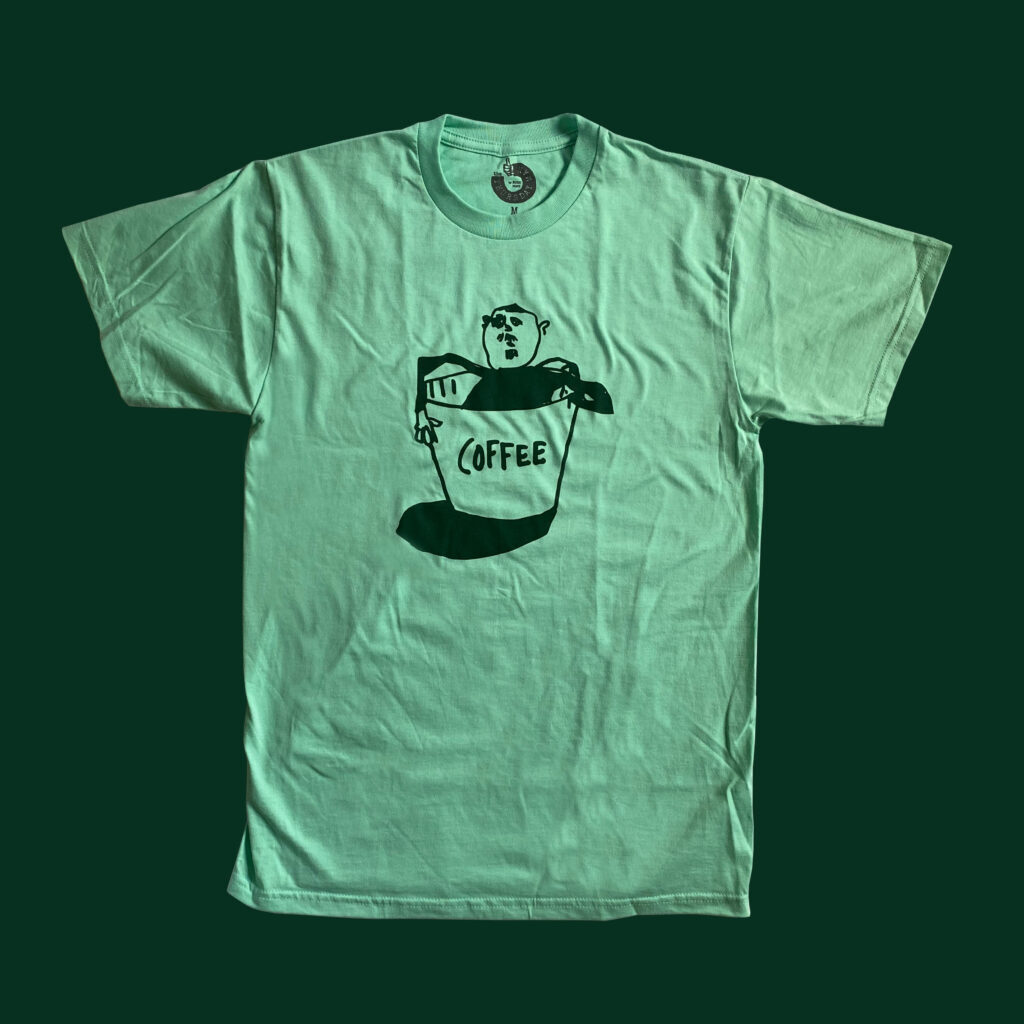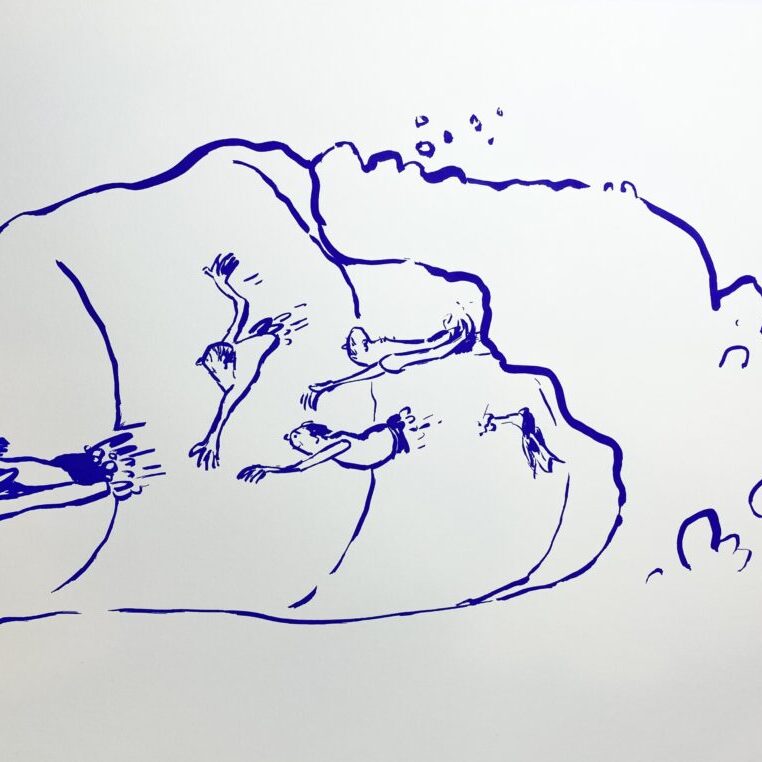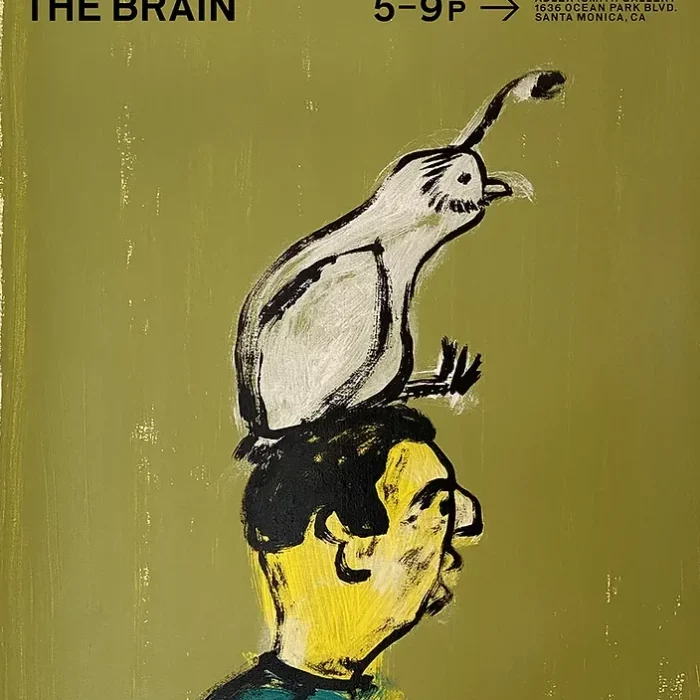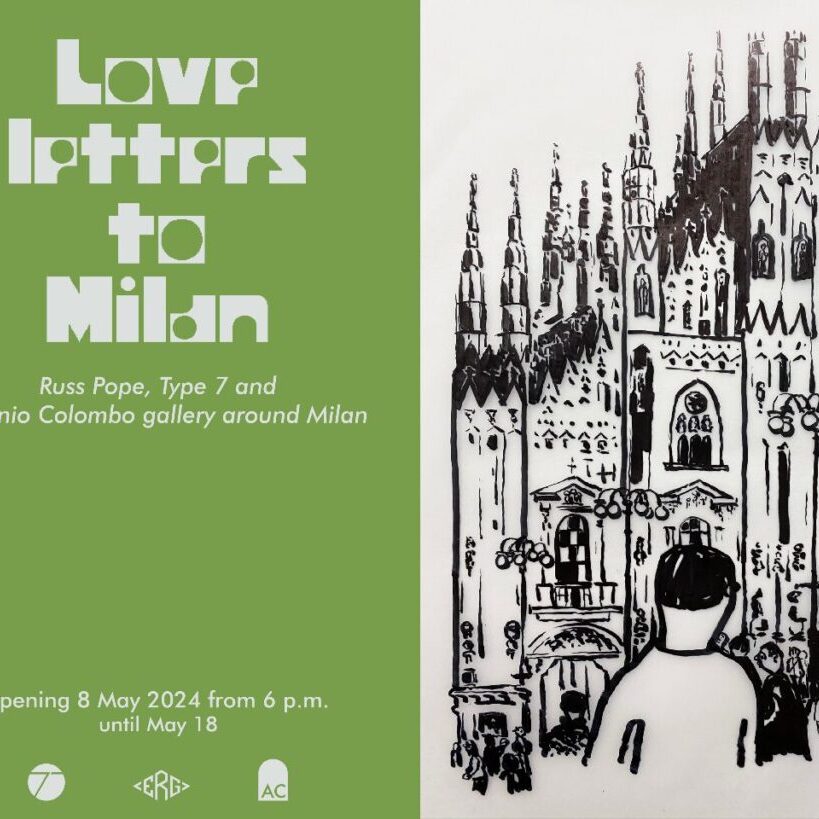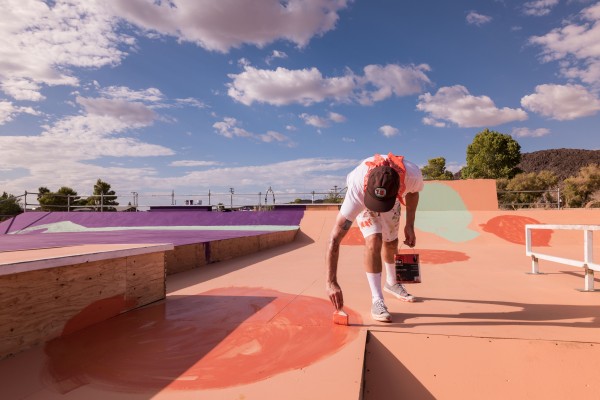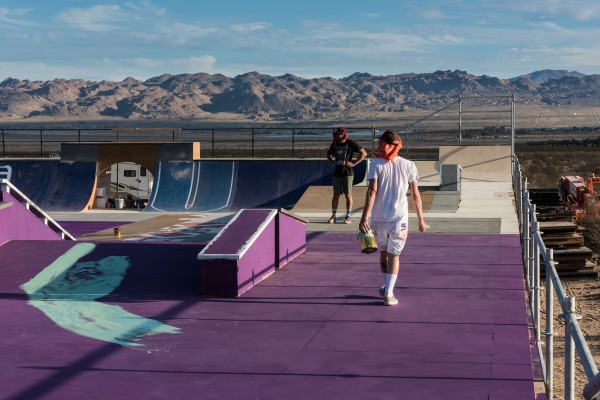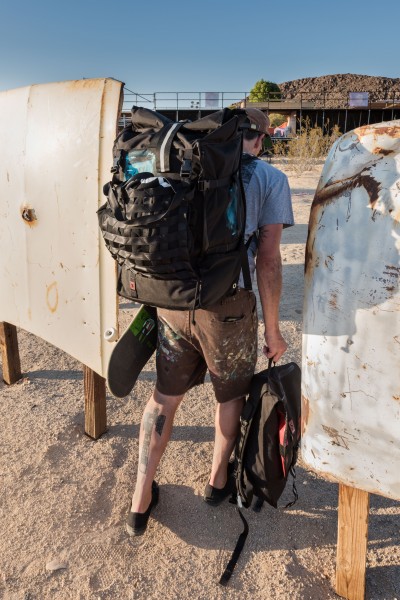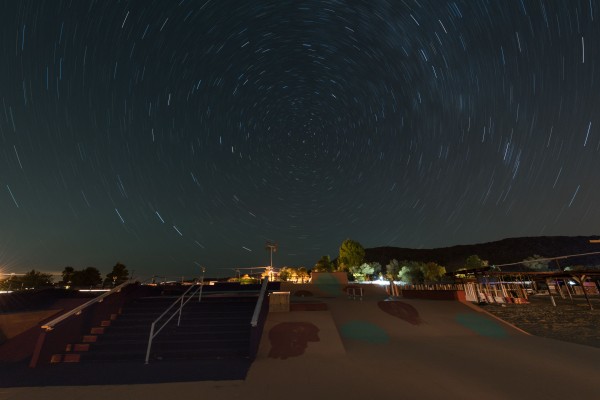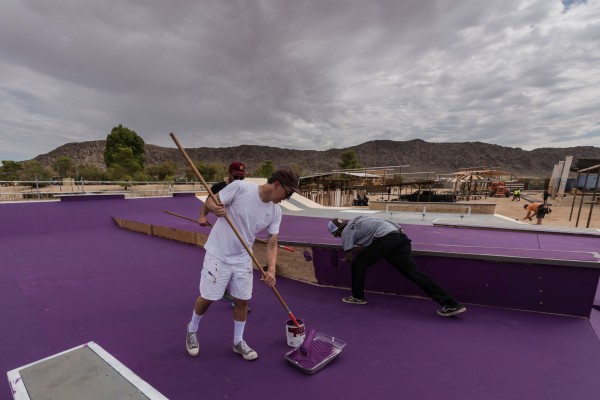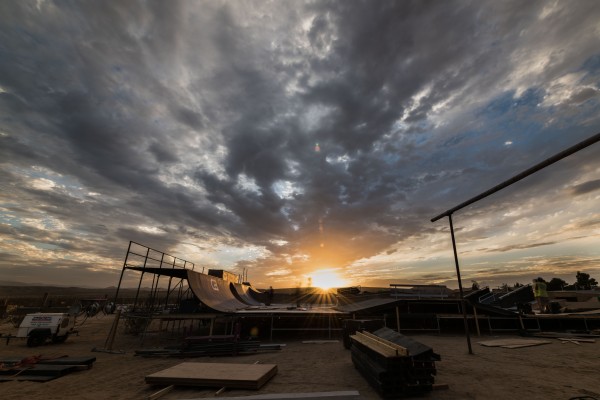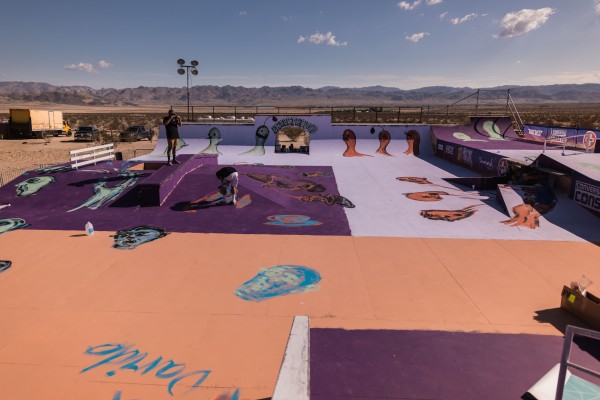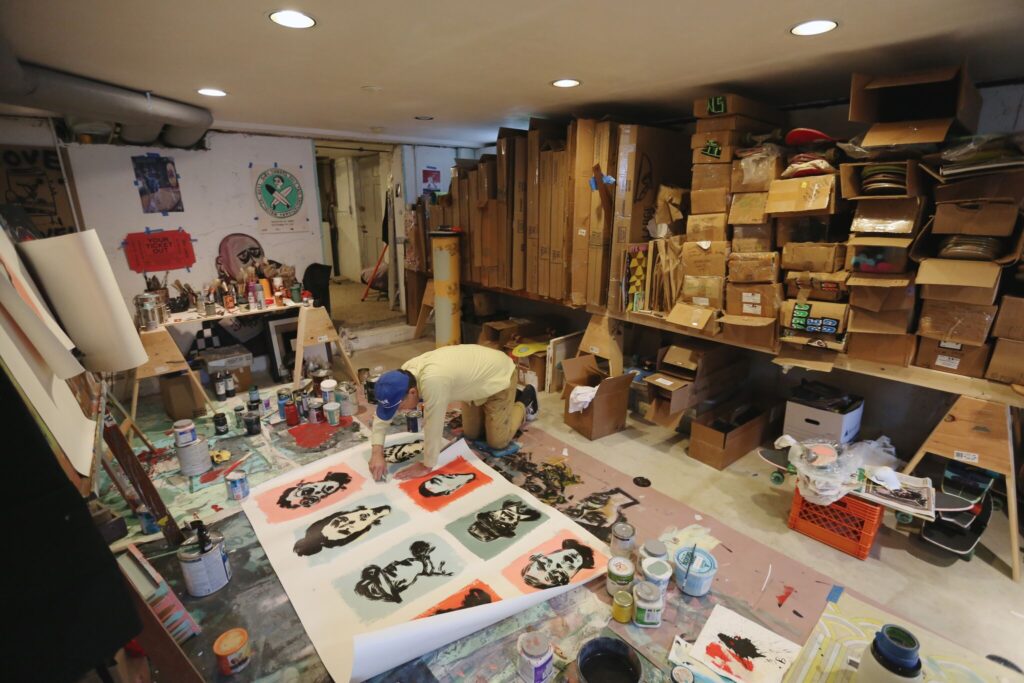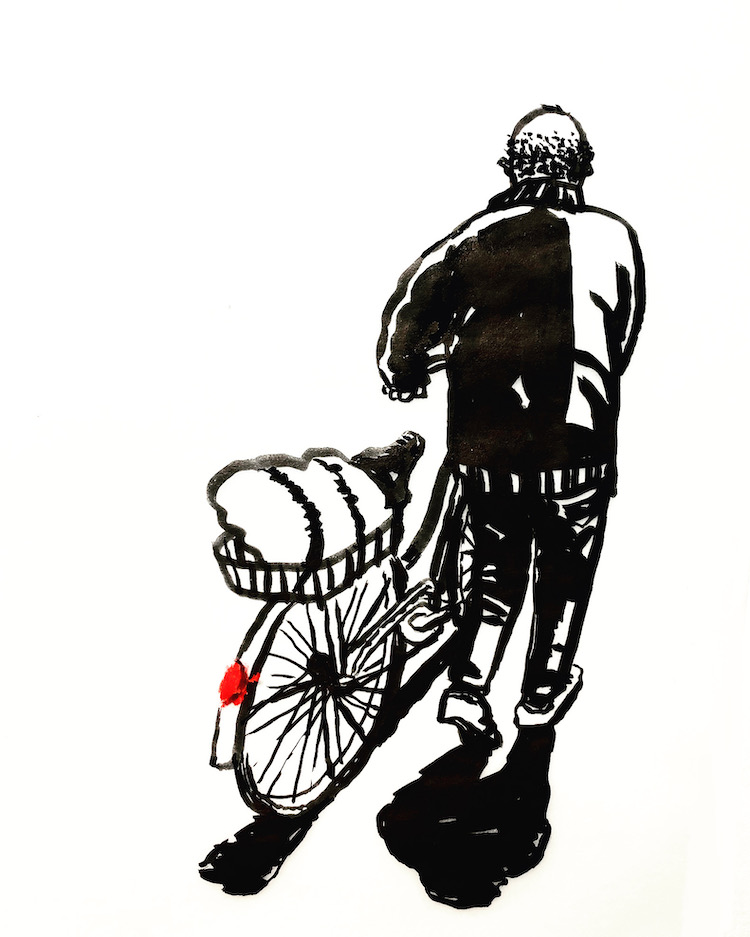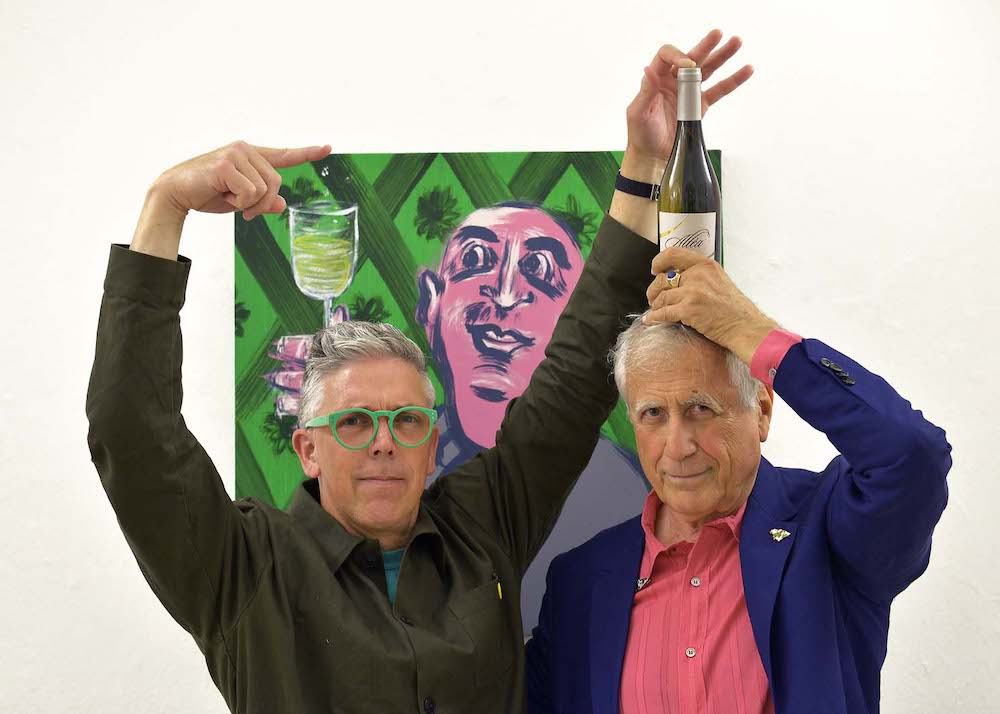Strength Magazine: February 2003 Vol.8 Issue 2

Artist, father, husband and the man behind many of your favorite skateboard graphics, Russ Pope , interviewed by his friend Ben Horton.
Ben : Ok, it’s time. This is the Russ Pope interview of November 2002. The first thing that we’d like to hear about is the background of your skateboarding career. Let’s start with Small Room Skateboards: What was your affiliation with Small Room Skateboards ?
Russ: I was a team rider and I worked on the different zines and black and white copy machine artwork that we did for logos and t-shirts and boards and stuff. I contributed artistically and with the team.
B: So you did some of the graphics for Small Room, hand-drawn stuff obviously, but you used the copy machine to distort things and stuff like that?
R: Ya, it was total zine-style. It was mostly copy machine art. The guy who ran the company, Louis, did a lot of different copy machine graphics. Some of it was drawn. It took different elements, either drawn, or found elements from books/photographs, or whatever. And then, wrecking them on the copy machine, turning them into black line art and then cutting rubies for the other layers to go underneath it.
B: Oh, that’s cool. The next company that you were involved with after Small Room was that SMA on the timeline.
R: Ya.
B: What was your involvement there?
R: For SMA, I was the team manager. While I was still riding for Small Room, I moved to Santa Cruz with my girlfriend, who is now my wife and I started working at NHS. I did sales for a year. Then I started running the team, you know, team manager stuff, doing the ads and art direction. It was when skateboarding was really taking a crap and everything was shrinking. NHS downsized quite a bit so everyone had to wear a lot of hats. Like, the team manager was also a brand manager. We did team promotions, art direction, ad design, even photography and video production.
B: Wow, that’s a lot of hats to wear. So was it from that point that Creature started?
R: Well, sort of. That went on for a while. We worked on a bunch of other projects during that time. We started a clothing brand for NHS while I was there. And after that is when I started Creature. There were a couple of people who rode for SMA, like Jason Adams, who wanted to do something new. I wanted to go do something new and we talked to a few people about doing a new company called Creature. But, I talked to Novak and he was up for starting a new project. So I went for it. I wanted to create something new instead of running something that already had a set image. I wanted to set the tone for its graphic imagery.
B: That’s great. Who all rode for Creature?
R: Barker Barrett, Jason Adams, Dorian Tucker, Darren Navarette, Ronnie Marshall. At the end, I think, Crazy Eddy did. But that would be it. It was pretty small. A tight knit bunch of guys.
B: So, you were basically the mastermind, you could say, behind Creature?
R: We took Creature in a completely different direction away from the way they typically did business at NHS. We set up all new foreign and domestic distribution for Creature. I basically barricaded myself up in this office; butcher papered the windows so no one could see in, and worked in my Creature cave. I didn’t really talk to anyone there about what I was doing. I tried to keep it as separate as possible with it still being there, which was difficult. It was a new market for them. I tried to just make it as separate as possible while still being under the same roof. In the long run, it turned out to be hard to do that. It was a real important thing to me then. But now, in retrospect, it probably wasn’t all that big of a deal. But it seemed like it was really what needed to happen at the time.
B: So, because you felt you needed to keep Creature separate from everything else that was going on at NHS, is that what sort of gave way to the beginning of another company called, Scarecrow?
R: Uh huh.
B: And you were completely the person behind Scarecrow as well, just like Creature, right?
R: Ya, but the difference was that I moved back to San Luis Obispo and went into business with a friend of mine, a partner in CCS, Mike Adamski. And we funded it ourselves. Whereas before it was NHS’s money, with Scarecrow it came from us. So it was truly our company. With Creature, it was our company, but when push came to shove, I didn’t own the name. That’s when I started Scarecrow. It was basically a continuation of Creature. It was like round two, I guess. We took everybody from Creature over there and added a few new people, Joe Nemeth, Ben Horton and a whole new wheel team.
B: Besides the location and the fact that it was your money with Scarecrow, would you say there were any other differences between Scarecrow and Creature?
R: Ya, definitely. Graphically it was similar, with spooky graveyard art. But it was completely different. I mean, NHS was huge, with a more corporate atmosphere. There were a bunch of really cool guys there, but at that time, for me, it wasn’t that appealing. With Scarecrow, it was just you and I in that old, spooky, haunted house looking place. We ended up calling it Haunted House Distribution. It was just two guys running around like crazy trying to make things happen. We were constantly answering phones, trying to sell skateboards, cut rubies, receive stuff, pack boxes, ship it out. We did a lot of things
NHS, or larger companies couldn’t do, like answering every phone call, making sure every box went out, if it missed UPS, we’d drive it to UPS to make sure it went out. And we were able to create sales, where we normally probably wouldn’t have been able to have them, just because we took good care of our people. And it was fun doing that because we were totally immersed in it. At least that’s how I felt.
B: Ya, definitely. I can say that everyone who got involved with Scarecrow got immersed in it. During that time of Scarecrow, or even as far back as Creature, were there many other companies using the horror-style graphics or even skulls then?
R: No. People had used skulls. Powell had used skulls. In the early eighties, everybody had their stereotypical gooey, skully graphic. But nobody else was doing the graveyard thing, the spooky graphics. Skateboarding was really in the hip hop world then. It was pretty Yo. So what we were doing was not perceived as cool by the general population. I’m sure you remember going to trade shows; we stuck out like a sore thumb. That worked for us. We were supplying stuff to a niche of people who didn’t want to be doing what everybody else was doing. At the same time, it prevented us from getting all that big, which was cool. It was fun. But it wasn’t the way it is now that punk rock skulls and spooky stuff are cool. We definitely got some strange looks from people.
B: So, you could say, in a way, it was pretty innovative. Not so much in the skull region, but in the horror and slash and terror-style of graphics.
R: It was pretty innovative. I think the only other person I knew who had done anything like that was Gavin O’Brien. He used Nosferatu and some bat stuff for Strange Notes and for some Santa Cruz stuff, like Ross Goodman had some gravedigger stuff. But those were all one-time deals. That wasn’t the company’s general theme. So, ya, I guess so.
B: Those were great graphics. Speaking of all the graphics today, what do you think about the resurrection of the dead-style graphics that we see so much of now?
R: For the people, who are truly into it, I think it’s super cool. I love to look at that stuff, Famous Monsters of Filmland and old black and white movies. I still love all that imagery. But most of it now is not based around that. I don’t mean this as a jab; most of it is just being done because people think that’s what they need to make in order to appeal to the kids of today. I guess they are just watching the trends.
B: What role does all of this, the companies you have worked for, the kind of imagery you like to see on skateboards and that you have created for skateboards and the lifestyle of being a skateboarder, what role does this play in your painting? Or does it play a role at all?
R: The stuff that I paint and draw is really not horror film imagery at all. My painting and drawing stuff, I really just do for me. I don’t have the desire to do art for skateboards, really. I have done them, but I don’t have the desire to subject myself to the scrutiny of a manufacturer or company judging my art by how well a skateboard sells. I just want to make my art for myself and if someone winds up digging it, cool. If not, that’s cool too.
B: You recently had an art show in Portland, Oregon.
R: So did you.
B: How do you feel about hanging your paintings on the walls in the gallery for people to see?
R: It’s cool. I don’t show with the idea of “man, I hope I sell a lot of paintings.” I show with the idea that this is going to be fun, having people come and react to my stuff, positively or negatively. I get what I get out of that and someone else will get something else out of it. But the commerce side of it is not a concern. I sell some stuff and other stuff doesn’t sell. That’s fine, it doesn’t really matter.
B: When I was there, I noticed some of the images, roosters, etc. were recurring in your paintings. Would you say this is a subconscious or conscious inclusion of these images?
R: I would say it’s both. I think I have a handful of characters I revisit on a regular basis. And then, I like to introduce new ones along with them: black brant ducks, the rooster or bulls.
B: What material do you use to make your paintings?
R: Raw ones.
B: What is the surface? What do you use?
R: Mixed media on canvas. Almost always its acrylics on canvas. Sometimes I use oil pastels or some collage. Occasionally it’s on wood. I did some bottles for the show in Portland too, and some drawings on paper.
B: For the acrylics, are you using brushes?
R: Ya.
B: Always?
R: Almost always. And then, all the paint I use is not art store paint; it’s Home Depot leftovers. It’s the mismatched, all the unwanteds. I try to find the paint store that has the most bad mixes. I don’t know if it’s because they have a crappy mixer or if people just don’t know how to pick colors. I buy gallons of bad mixes for real cheap. Then I can be more frivolous with it.
B : What are you looking for when you are picking out these colors? Are you looking for bright colors, dull colors, similar colors to what you already have?
R: I have some favorites like a baby blue, pale olive colors, seafoam green. I try to seek those out. I buy those and some bright colors for accents. But the bright colors are usually hard to find.
B: So, speaking of these bright colors and things you like, are there any painters that have influenced you?
R: Neil Blender, Chris Johanson’s stuff, Basquiat, Thomas’s, Rauschenberg, my son, Blaize’s art and children’s art in general, your stuff.
B: Besides painters, are there any people that come up and are influencing you in the thoughts that you put down on the canvas?
R: Yes, everyone I see. I have sketchbooks all over the place, on my desk at work, in my backpack. I see stuff out in the world, like a kooky guy, and I’ll come back and draw him. Or I’ll pick up on things people say. You know, I deal with a lot of people, and it’s amazing some of the things that come out of their mouths. I’ll make paintings from their quotes. Or even lines from a song can make me want to make a painting.
B: Like when you are listening while you are painting?
R: Ya, or even when I’m driving I’ve written down lines from a song to incorporate into a painting. But, definitely the music I listen to while I’m painting is influential, especially with the background stuff.
B: Is there anything that you tend to think about while you are painting? Like the characters you come back to, consciously or subconsciously. Or is it more of a therapeutic-type process where you are relaxing and clearing your mind?
R: I guess I come back to music all the time. I’m always thinking of music because I usually have my headphones on while I’m painting. The brushstrokes and the backgrounds of what I’m painting or the colors are all motion, music. You can see the background motions, swipes and different colors that might groove with that music: Coltrane [UU1] [UU2] , Devo, The Hunns, whatever, they become strokes.
B: How often do you paint?
R: Sometimes it’s daily. Right now, I’ve been on a three-week binger. I’ll get home and do the dinner routine with my family. Then I’ll go out into the garage and be out there until two in the morning. I come out, scrub down, go to sleep and go to work. I’ll do that every day for weeks. Then, other times, I will just draw in my sketchbook and not touch a paintbrush for weeks.
B: That’s pretty amazing to paint every day for weeks like that. What advice would you give to people reading this who maybe can’t get their thoughts together or find time to really concentrate and paint and get things done. For some people there is kind of a blockage there. What would you say? What makes it flow for you?
R: Sometimes I will have a rough night when it’s just not working. I will go out there and everything I’m doing sucks. It used to be that I’d stop. But now, most of the time, I’ll just keep painting. Even if I think what I’m doing isn’t great or I’m not into what I’m doing. I’ll just keep rolling with it and somewhere down the line, I will be feeling it and I’ll start having a great time. And if that is not the case and I go out into the garage the next morning and think what I’ve done is awful, I just paint over it. That’s the hot thing about painting. It’s your deal; if you aren’t into it, just paint over it. But I really want to lay a line down and leave it. I don’t want to toil over it. I want to lay it down and have it work and leave it there.
B: Do you see a movement going on in skateboarding right now kind of like an art/skateboarding movement of people who are in the skateboarding industry that are also doing a lot of art and it kind of getting popular? Or, do you see the creative drive behind skateboarding and the art that has always been in skateboarding getting more popular because skateboarding is getting more popular?
R: That’s a tough one. I think that the act of skateboarding itself used to be an artistic thing, and in my opinion, it’s much less so now. It was an artistic thing to be involved with in the old days with paint-penning on your grip tape or on your shoes, customizing clothing, or making flyers, all that type of stuff. That’s all artistic stuff. There is an artistic side to skateboarding. It’s being creative. Skateboard culture, in general, has become more popular; there are people who still do this stuff but not the majority of skateboarders. That’s ok, though, things change.
B: You could say that all aspects of skateboarding have become popular, including the art and the creative side of it. Let’s talk about what you think about while you are painting. When you go out there, in the garage, throwing the paint on the canvas, what are you thinking about?
R: Typically, by the time I go out there and start to paint, I know what I’m going to lay down, as far as all the black line images on top. So that has pretty much already been decided. I keep a bunch of sketchbooks all over the place and the drawings I wind up liking enough to make a painting of, I do. But the backgrounds and colors and the brush strokes and movements and stuff that give the painting life, these happen because of what I’m thinking of at that moment, which is typically music. I almost always listen to music when I’m painting. Whatever I’m listening to definitely influences the colors I’m using and the strokes I’m laying down. The stuff I lay down on top of that usually comes from my sketchbook as reference material.
B: Where is Russ Pope now in the world of skateboarding/art?
R: I work at Black Label Skateboards. I get up and go work with Black Label dudes: Lucero, Tom, Patrick and everyone on the team. That’s what I do.
B: Are you involved in the creative process there?
R: Absolutely. John is the creative man behind Black Label, but he’s cool, in that, he will take creative direction and ideas from other people. So, I definitely get involved with creative direction there.
B: What creative things are you doing currently?
R: I just did a t-shirt for RVCA for the Artist’s Network Program. They have artists do t-shirts for them and then they have the artists chose a charity to donate a percentage of the proceeds to. They have done t-shirts with Templeton, Neil (Blender), Barry McGee, Mark Mothersbaugh, Jason Lightle, a whole bunch of people, anyway I just did one of those and it’s coming out in the spring. RVCA is also organizing an Artist’s Network Program art show for spring of next year, so I’m doing that. I’m working on this interview for Strength and putting some small stuff together for a small show in London. My friend, Shon, is building my website, russpope.com (it should be up now). I’m also working on this small bag side project, it will be distributed by Giant. Basically just these ghetto, non-technical canvas bags that will be silk-screened on. Super simple stuff. It’s the opposite of what other people are doing right now.
B: You designed these bags?
R: Yes. It is just a couple. Then we may do more. It will either work or flop. It’s a cool creative thing to do for people who don’t want to walk around with a storm-proof, zipper clad, water bottle holding bag.
B: Where will we be able to find these bags?
R: Skateboard shops. Giant will be distributing them.
B: You mentioned you did some graphics in the past, have you done any lately?
R: Ya, I did a series of graphics called the funeral series for Black Label. It was a Scarecrow or Creature-esque series of graphics. A one shot deal, John asked me if I would be into it and I was, so we did it.
B: What closing comments do you have?
R: Thank you to all the people who have enabled me to live my life as a skateboarder, both as a skateboarder and to financially make my living off of skateboarding. I feel fortunate that I don’t have to get up and go to a stereotypical job every day. I get to go to work with friends and look at artwork and touch and hold skateboards all day long. I get to do business with people I enjoy doing business with. Thank you to Denike and Novak for giving a younger me a chance. Mike Adamski for partnering up with me for Scarecrow. Jim, CCS, Savier, Lucero, anybody who has been willing to work with me and helped me stay in skateboarding through the years. I also want to thank my wife, Jennifer, Ben and all who have supported me artistically whether by buying my art or helping book a show or supplying subject matter to paint from. Thanks.

